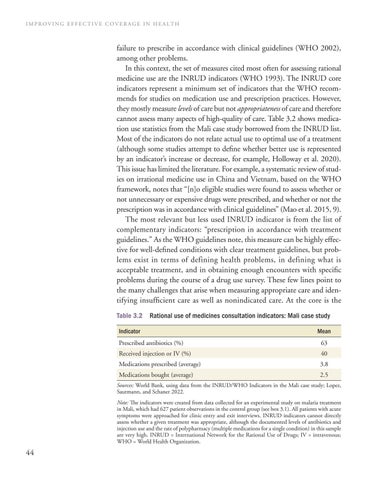IMPROVING EFFECTIVE COVERAGE IN HEALTH
failure to prescribe in accordance with clinical guidelines (WHO 2002), among other problems. In this context, the set of measures cited most often for assessing rational medicine use are the INRUD indicators (WHO 1993). The INRUD core indicators represent a minimum set of indicators that the WHO recommends for studies on medication use and prescription practices. However, they mostly measure levels of care but not appropriateness of care and therefore cannot assess many aspects of high-quality of care. Table 3.2 shows medication use statistics from the Mali case study borrowed from the INRUD list. Most of the indicators do not relate actual use to optimal use of a treatment (although some studies attempt to define whether better use is represented by an indicator’s increase or decrease, for example, Holloway et al. 2020). This issue has limited the literature. For example, a systematic review of studies on irrational medicine use in China and Vietnam, based on the WHO framework, notes that “[n]o eligible studies were found to assess whether or not unnecessary or expensive drugs were prescribed, and whether or not the prescription was in accordance with clinical guidelines” (Mao et al. 2015, 9). The most relevant but less used INRUD indicator is from the list of complementary indicators: “prescription in accordance with treatment guidelines.” As the WHO guidelines note, this measure can be highly effective for well-defined conditions with clear treatment guidelines, but problems exist in terms of defining health problems, in defining what is acceptable treatment, and in obtaining enough encounters with specific problems during the course of a drug use survey. These few lines point to the many challenges that arise when measuring appropriate care and identifying insufficient care as well as nonindicated care. At the core is the Table 3.2
Rational use of medicines consultation indicators: Mali case study
Indicator
Mean
Prescribed antibiotics (%)
63
Received injection or IV (%)
40
Medications prescribed (average)
3.8
Medications bought (average)
2.5
Sources: World Bank, using data from the INRUD/WHO Indicators in the Mali case study; Lopez, Sautmann, and Schaner 2022. Note: The indicators were created from data collected for an experimental study on malaria treatment in Mali, which had 627 patient observations in the control group (see box 3.1). All patients with acute symptoms were approached for clinic entry and exit interviews. INRUD indicators cannot directly assess whether a given treatment was appropriate, although the documented levels of antibiotics and injection use and the rate of polypharmacy (multiple medications for a single condition) in this sample are very high. INRUD = International Network for the Rational Use of Drugs; IV = intravenous; WHO = World Health Organization.
44

